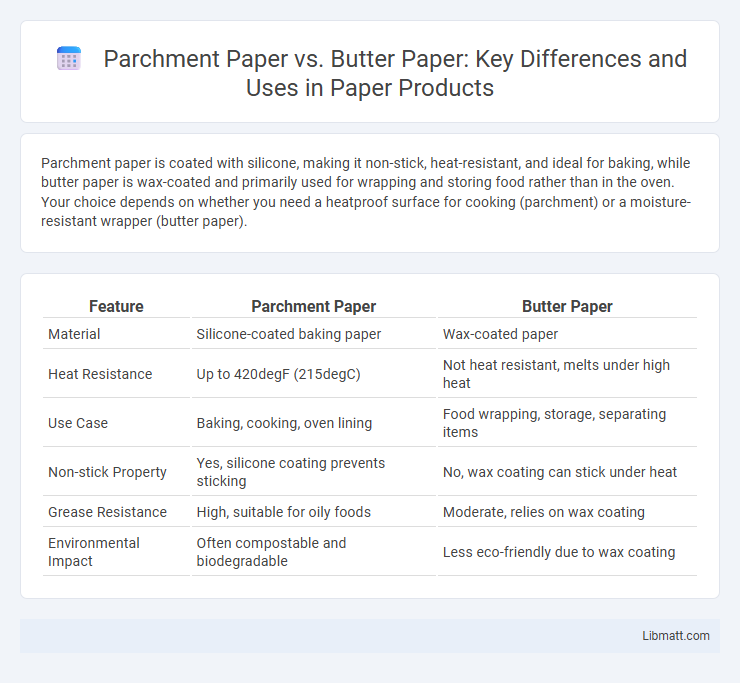Parchment paper is coated with silicone, making it non-stick, heat-resistant, and ideal for baking, while butter paper is wax-coated and primarily used for wrapping and storing food rather than in the oven. Your choice depends on whether you need a heatproof surface for cooking (parchment) or a moisture-resistant wrapper (butter paper).
Table of Comparison
| Feature | Parchment Paper | Butter Paper |
|---|---|---|
| Material | Silicone-coated baking paper | Wax-coated paper |
| Heat Resistance | Up to 420degF (215degC) | Not heat resistant, melts under high heat |
| Use Case | Baking, cooking, oven lining | Food wrapping, storage, separating items |
| Non-stick Property | Yes, silicone coating prevents sticking | No, wax coating can stick under heat |
| Grease Resistance | High, suitable for oily foods | Moderate, relies on wax coating |
| Environmental Impact | Often compostable and biodegradable | Less eco-friendly due to wax coating |
Understanding Parchment Paper
Parchment paper is a heat-resistant, non-stick baking sheet made from cellulose fibers treated with silicone, making it ideal for oven use up to 420degF (215degC). Unlike butter paper, which is primarily used for food wrapping and lacks heat resistance, parchment paper prevents sticking and promotes even cooking when baking cookies, roasting vegetables, or preparing fish. Your choice of parchment paper ensures better cooking performance and easier cleanup compared to butter paper in culinary applications.
What is Butter Paper?
Butter paper is a semi-translucent, grease-resistant paper commonly used in cooking and baking to wrap foods or line surfaces, helping to prevent sticking and moisture transfer. It is coated with a thin layer of wax or silicone, providing a non-stick surface ideal for tasks like wrapping butter, sandwiches, or pastries. You can use butter paper as an alternative to parchment paper in some applications, though it may not withstand high oven temperatures as effectively.
Key Differences Between Parchment Paper and Butter Paper
Parchment paper is coated with a thin layer of silicone, making it non-stick, heat-resistant, and suitable for baking, while butter paper is typically wax-coated and primarily used for wrapping food rather than baking. The heat tolerance of parchment paper reaches up to 420degF (215degC), whereas butter paper's wax coating can melt or smoke at high temperatures. Parchment paper's non-stick properties and heat resistance make it ideal for cooking and baking, whereas butter paper is better suited for food storage and presentation.
Uses of Parchment Paper in Baking
Parchment paper is essential for baking as it provides a non-stick surface that prevents cookies, cakes, and pastries from sticking to pans, ensuring even baking and easy cleanup. It withstands high oven temperatures up to 420degF (215degC), making it ideal for lining baking sheets and cake tins. Your baked goods benefit from moisture retention and crisp edges when using parchment paper.
Common Applications of Butter Paper
Butter paper, known for its grease-resistant and non-stick properties, is commonly used in baking and food wrapping to preserve freshness and prevent sticking. It is ideal for lining cake tins, wrapping sandwiches, and separating baked goods like cookies and pastries. Your kitchen tasks benefit from butter paper's moisture-resistant surface, making it practical for both cooking and storage purposes.
Heat Resistance: Parchment vs. Butter Paper
Parchment paper offers superior heat resistance, typically withstanding temperatures up to 420degF (215degC), making it ideal for baking and roasting without burning or melting. Butter paper, also known as wax paper, has a lower heat tolerance due to its wax coating, which can melt or smoke at temperatures above 200degF (93degC), making it unsuitable for oven use. When cooking or baking, your choice between parchment and butter paper should consider their distinct heat resistance to ensure safety and optimal results.
Non-Stick Properties Compared
Parchment paper features a silicone coating that provides excellent non-stick properties, making it ideal for baking and cooking without food adhering to the surface. Butter paper lacks this silicone layer, resulting in less effective non-stick performance and potential sticking issues with sticky or greasy foods. For reliable non-stick results in high-heat applications, parchment paper is the superior choice compared to butter paper.
Environmental Impact and Reusability
Parchment paper, typically made from cellulose fibers and coated with silicone, is compostable and often biodegradable but requires industrial composting for optimal breakdown, whereas butter paper, primarily wax-coated, is less environmentally friendly due to its petroleum-based wax and limited compostability. Reusability favors parchment paper as its non-stick silicone layer withstands multiple uses and baking cycles without degradation, while butter paper's wax coating tends to melt and deteriorate quickly, limiting it to single-use applications. Choosing parchment paper reduces waste and supports sustainable kitchen practices more effectively than traditional butter paper.
Which Paper Should You Choose for Baking?
Parchment paper is heat-resistant and non-stick, making it ideal for baking cookies, roasting vegetables, and lining cake pans to prevent sticking and ensure even cooking. Butter paper, often wax-coated, is moisture-resistant but not heat-resistant, so it's better suited for wrapping food rather than baking. For reliable performance in the oven, choose parchment paper to avoid melting or burning issues associated with butter paper.
Frequently Asked Questions: Parchment Paper vs. Butter Paper
Parchment paper is non-stick, heat-resistant, and commonly used for baking, while butter paper is primarily designed for wrapping and storing food. Frequently asked questions often address whether butter paper can replace parchment paper for baking, with experts advising against it due to butter paper's lower heat tolerance and tendency to stick. Users also inquire about environmental impact, with parchment paper being uncoated and more eco-friendly compared to wax-coated butter paper.
parchment paper vs butter paper Infographic

 libmatt.com
libmatt.com